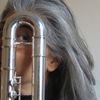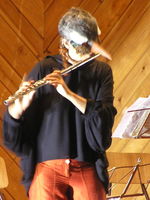
alessandra giura longo
la flûte est un oiseau rebelle

It would seem that the sound of the flute has always been associated with birdsongs. At various times in history, in far-flung geographical locations, and despite differences in construction and playing techniques, the clear, airy and silvery timbre that characterizes the instrument, together with its sharp agility, have identified in the minds of many composers and in different musical situations the natural song of birds with the artful voice of the instrument.
But there is more. This evening you will hear pieces inspired by birdsongs –sweet and melodious – but also musical representations of soaring flight, distant or piercing and quick; the tremulous and vibrant fluttering of wings; sudden sharp movements dictated by some unknown instinct... The concert opens with a series of variations for solo flute based on Pagageno's aria, Der Vogelfänger bin ich, ja ("I am the bird catcher") from Wolfgang Amadeus Mozart’s opera, Die Zauberflöte. The practice of transcribing or arranging well-known and beloved opera arias for instruments was very popular in the 19th century, and Franz Anton Hoffmeister could only have chosen the flute for an aria on such a text!
It's a long way from Viennese music of the early 1900s to folk music from distant China, but it appears that the Chinese also used the Ti, a transverse flute of bamboo, to represent the flight of the partridge (the piece has been transcribed for modern flute).
It is followed by two French works from the 20th century: Oiseaux by Jean Rivier and Le Merle Noir by Olivier Messsiaen. Again, a different musical language. And yet again, an attempt to portray the world of birds through music. Messiaen meticulously and methodically studied various birdsongs and translated them into music, creating diverse works inspired by the winged inhabitants of the French provinces. Examples (to name just two) are the famous Catalogue d’Oiseau for piano and, of course, Le Merle Noir for flute and piano.
March of the Bluebirds by the Czech composer Leos Janacek and Nightengale by the German, Ernst Köhler, both for piccolo and piano, take us back to the salons of the 19th century. The first uses a march in which we seem to see a row of cartoon bluebirds leaping about as they try to steal one another’s place in line. The second is an exhilarating and virtuosic polka which perfectly exemplifies the almost “kitch” musical language of popular music of its time.
The evening concludes with a concert by Antonio Vivaldi entitled Il Gardellino (“The Goldfinch”), one of many instrumental concerts for which the Venetian composer turned to nature for inspiration. Again, in the musical language of the baroque, Vivaldi finds the means and the expressive devices capable of depicting the warbling and leaps of the little bird. The title of the concerto is a clear reference to the first verse of the habanera from Georges Bizet’s opera Carmen, in which the word “amour” has been substituted with the word “flute”.
The mask worn by AGL was created by Paoletta Garau.





